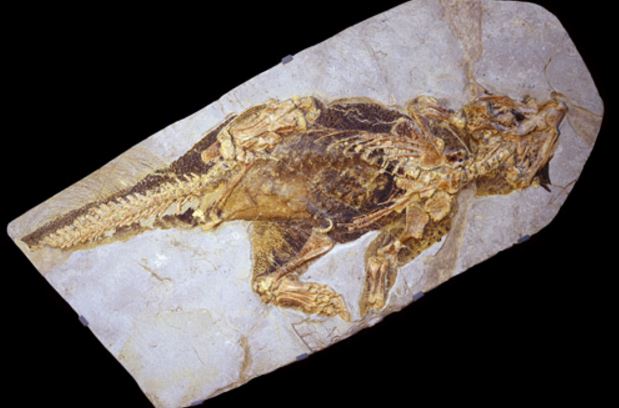Psittacosaurus, a small dinosaur, could change the colour of its skin, says a team of scientists from the UK, Germany and Hong Kong. After reconstructing the colour patterns of the exceptionally well-preserved dinosaur from China, the team found that the long-lost species was dark on top and lighter on its underside.
Dr. Jakob Vinther, from the University of Bristol’s Schools of Biological Sciences and Earth Sciences in England, and colleagues explained in the academic journal Current Biology that Psittacosaurus’ colour pattern, known as countershading, is a very common form of camouflage in today’s animals.
The researchers believe that Psittacosaurus probably lived in a forest-type environment – one where there was diffuse light. They believe their reconstruction of this animal is the most life-like ever made of a dinosaur.
 Psittacosaurus means ‘parrot lizard’ because of its parrot-like beak. (Image: Bristol University. Credit: Jakob Vinther)
Psittacosaurus means ‘parrot lizard’ because of its parrot-like beak. (Image: Bristol University. Credit: Jakob Vinther)
Psittacosaurus preserves clear countershading
Dr. Vinther said:
“The fossil, which is on public display at the Senckenberg Museum of Natural History in Germany, preserves clear countershading, which has been shown to function by counter-illuminating shadows on a body, thus making an animal appear optically flat to the eye of the beholder.”
Professor Innes Cuthill, a behavioural ecologist from Bristol University’s School of Biological Sciences, explained:
“By reconstructing a life-size 3D model, we were able to not only see how the patterns of shading changed over the body, but also that it matched the sort of camouflage which would work best in a forested environment.”
 An extremely well-preserved Psittacosaurus fossil – early Cretaceous (120 million years old). Its skin and colour patterns are still present. (Image: Bristol University. Jakob Vinther and Robert Nicholls)
An extremely well-preserved Psittacosaurus fossil – early Cretaceous (120 million years old). Its skin and colour patterns are still present. (Image: Bristol University. Jakob Vinther and Robert Nicholls)
Countershading probably protected Psittacosaurus – a relative of the triceratop – from predators that used the patterns of a shadow on an object to determine its shape – we do that.
Dr. Vinther said he realised that structures previously believed to be dead bacteria or artifacts in fossilized feathers were, in fact, melanosomes. A melanosome is an organelle found in animal skin and feather cells and is the site for synthesis, transport and storage of melanin. Melanosomes are responsible for photoprotection and colour in animal tissues and cells.
Preserved melanin in Psittacosaurus fossils
In Psittacosaurus fossils and other well-preserved specimens, the scientists say it is possible to make out patterns of preserved melanin with the naked eye – without the aid of a microscope.
The Bristol scientists have also been exploring the distribution of countershading in animals that exist today. However, it was extremely difficult to apply the same principles to an animal that had gone extinct and had been crushed flat and fossilized.
They teamed up with Bob Nicholls, an artist with 20 years’ experience in creating anatomically accurate reconstructions of natural history specimens using a unique and thorough reconstruction process. The aim was to reconstruct this remarkable fossil into a physical model which ‘is the most scientifically accurate life-size model of a dinosaur with its real colour patterns.’
Nicholls took measurements of the bones, studied the preserved scales and pigment patterns, and received muscle structure data from Bristol palaeontologists Dr. Stephan Lautenschlager and Professor Emily Rayfield. After several painstaking months, he completed the careful modelling of the dinosaur.
According to Nicholls:
“Our Psittacosaurus was reconstructed from the inside-out. There are thousands of scales, all different shapes and sizes, and many of them are only partially pigmented. It was a painstaking process but we now have the best suggestion as to what this dinosaur really looked like.”
Psittacosaurus lived forests
In order to determine what kind of environment Psittacosaurus lived and evolved in, the Bristol team made another cast of the model and painted this one all grey.
It was then placed in the Cretaceous plant section of Bristol Botanic Garden and photographed under an open sky as well as below trees to see how its shadows were cast under those conditions.
By making a comparison of the shadow with the pattern in the fossil, they were able to then predict Psittacosaurus’ habitat.
Dr Vinther said:
“We predicted that the psittacosaur must have lived in a forest. This demonstrates that fossil colour patterns can provide not only a better picture of what extinct animals looked like, but they can also give new clues about extinct ecologies and habitats.”
“We were amazed to see how well these color patterns actually worked to camouflage this little dinosaur.”
Psittacosaurus, which Prof. Cuthill describes as ‘weird and cute, with horns on either side of its head and long bristles on its tail,’ lived in China during the early Cretaceous period. It was found in the same rock strata where several feathered dinosaurs had been unearthed.
Evidence from plant and wood fossils suggests that the when Psittacosaurus was alive the whole area was a forest environment.
The team would now like to explore other kinds of camouflage in fossils, and use their latest findings to get a better understanding of how predators could perceive the environment and how they shaped evolution and biodiversity.
Citation: “3D Camouflage in an Ornithischian Dinosaur,” Jakob Vinther, Robert Nicholls, Stephan Lautenschlager, Michael Pittman, Thomas G. Kaye, Emily Rayfield, Gerald Mayr & Innes C. Cuthill. Current Biology. Published 15th September 2016. DOI: 10.1016/j.cub.2016.06.065.
Video – Dinosaur Camouflage
In this Cell Video Abstracts video, Dr. Vinther explains how they created the most life-like model of a dinosaur, preserving its skin and colour patterns.

